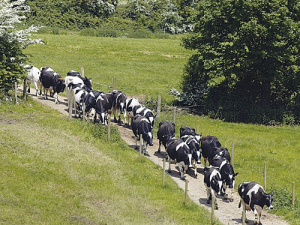He used to say only four main lesions causing lameness should concern NZ farmers: white-line damage, sole damage, axial cracks and foot-rot.
“However, now I am starting to think that one day we might have to add a fifth condition – digital dermatitis (DD),” he told the NZ Veterinarian Association dairy conference in a paper.
In 2012 he investigated lameness in Chile where DD was causing a huge problem on pastoral farms. Simple white-line injuries, sole injuries and axial cracks were infected with DD bacteria and refused to heal.
Returning to NZ he found here six reports of suspected cases, the first in 2004.
After writing newsletters to Taranaki farmers and talking at NZVA branch meetings around the country, 40 positive herds were identified in the following two years. A bovine digital dermatitis working party was set up at Massey University.
In 2013 in North Taranaki, they were aware of four farms with lesions diagnosed as DD; all were small and none of the cows was lame.
“We postulated there could be undiagnosed farms in our district; this needed investigation.”
A screening project was set up for North Taranaki in 2014-15. A total of 224 herds (60,445 cows) were screened between September 2014 and February 2015.
“To our surprise, at this initial screening, 143 (64%) of the herds had at least one cow with a DD foot lesion.
“The average within-herd prevalence of the 143 positive herds was low at 1.91%, with a range of 0.18% to 12.64%.”
The laboratory findings confirmed that most of the lesions sampled were consistent with a diagnosis of DD.
It was decided in March 2015 to repeat the screening of the first 114 herds to see if the prevalence had changed with time and season. At this repeat screening, 68 (59.6%) of the 114 herds were positive.
“An interesting finding was that 11 of the now positive herds had been negative at the first screening. To complicate things further, 19 herds found previously positive were now negative at the repeat screening. This surprise finding led us to the design of the second year of the project.”
The aim of this second-year project was to examine in more detail the observation that some herds had changed from negative to positive and vice-versa.
Fifty-seven herds were selected to be screened five times at six week intervals; each had been ‘positive’ during the previous season.
At the first screening of the 57 herds selected no lesions were found in 24 herds. At the second screening only nine herds had no lesions found. By the end of the five screenings only two herds remained ‘negative’ at every screening.
The average prevalence within herds had dropped from 2.52% (0-12.64%) in the previous season to 1.12% (0-8.46%) this season.
Part of the explanation for the drop was possibly the treatments and prevention measures used by some farmers.
Although the average prevalence was only 1.12% throughout the season, the lesion incidence average per farm was 3.45% over the whole year. A total of 608 different cows had lesions seen.
An interesting observation was that, despite the low prevalence, exactly 50% of the positive animals (304 cows) had lesions in both rear feet.
A lot of data is still to be examined and this is being done by a Massey graduate.
But Chesterton noted both the prevalence and incidence was higher in rotary platforms than in herringbone sheds.
“We suspect this could simply be because it is easier to examine feet when the cow is at right-angles to the observer. This prompts the question ‘is the incidence higher in herringbone sheds than is recorded in this study?’ “
With no front feet inspected and no lifting to check between claws “we expect both the incidence and prevalence figures in this study are conservative”.
The same Massey PhD student screened herds in four other provinces in the 2016-17 season to see if the disease had a similar prevalence to Taranaki.
Herds were sourced in Waikato (40 herds), Manawatu (41), West Coast (27) and Southland (19).
The surprising result was that in all regions except the West Coast there was a significant number of positive herds: 85% of Waikato herds were positive, 36.6% of Manawatu herds and 73.7% of Southland herds. Not one West Coast herd had a visible case of digital dermatitis.
As found in Taranaki, the percentage of cows positive in the herds was very low, averaging between 1.1% and 2.9%.
















